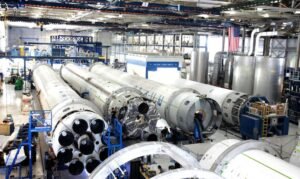Open AI vs. Closed AI
Artificial Intelligence (AI) has become an integral part of modern society, transforming industries and revolutionizing the way we live and work. When discussing AI, two important terms often come up: Open AI and Closed AI. These refer to different approaches and philosophies in developing AI systems. Understanding the differences between Open AI and Closed AI is crucial in navigating the complex landscape of AI development and deployment.
Key Takeaways:
- Open AI and Closed AI represent different approaches in AI development.
- Open AI promotes transparency, collaboration, and unrestricted access to AI technologies.
- Closed AI emphasizes proprietary systems, limited access, and controlled development.
- The choice between Open AI and Closed AI depends on the intended use, ethical considerations, and potential risks associated with AI technologies.
Understanding Open AI
In the context of AI, Open AI refers to the development philosophy that promotes transparency, accessibility, and collaboration. Open AI projects, codebases, and research are typically made publicly available, allowing anyone to study, modify, and distribute the technology. This approach encourages innovation and knowledge-sharing within the AI community.
Understanding Closed AI
On the other hand, Closed AI represents a more proprietary and controlled approach. In Closed AI systems, access to underlying technologies, codes, and data is restricted, often kept within the confines of the organization developing the AI. Closed AI may involve restrictions on the modification and distribution of the technology to maintain control and protect intellectual property.
Comparing Open AI and Closed AI
| Open AI | Closed AI |
|---|---|
| Promotes collaboration and knowledge-sharing. | Emphasizes proprietary systems and limited access. |
| Accessible to a wide range of stakeholders. | Access often limited to the organization developing the AI. |
| Encourages innovation from various contributors. | Allows for tighter control over the technology. |
Benefits and Risks of Open AI and Closed AI
Benefits of Open AI:
- Increased collaboration and collective intelligence.
- Accelerated innovation and progress in the AI field.
- Transparent decision-making processes.
- Openness helps identify and mitigate biases.
Benefits of Closed AI:
- Protection of proprietary technologies and data.
- Control over the use and distribution of AI systems.
- Potential for competitive advantage in the market.
- More secure against potential misuse or malicious intent.
Risks of Open AI:
- Unauthorized modifications and potential security vulnerabilities.
- Risk of bias and ethical concerns due to open development.
- Lack of accountability and difficulty in attribution.
- Potential for misuse or weaponization of AI technology.
Risks of Closed AI:
- Reduced transparency and limited public scrutiny.
- Potential for monopolistic behavior and restricted competition.
- Biases and ethical concerns within closed development environments.
- Less opportunity for collective intelligence and diverse perspectives.
Future Prospects and Considerations
The choice between Open AI and Closed AI depends on various factors, including the intended use of AI technologies, ethical considerations, and potential risks. Certain applications of AI may benefit from openness and collaboration, while others may require tighter control and confidentiality. Striking a balance between these two approaches will shape the future of AI development and deployment, ensuring a responsible and inclusive AI ecosystem.
Summary
Open AI and Closed AI represent diverging philosophies in AI development, with Open AI promoting transparency, collaboration, and accessibility, while Closed AI emphasizes control, proprietary systems, and limited access. The choice between these approaches depends on the intended use, ethical considerations, and potential risks associated with AI technologies. Striking the right balance is key to harnessing the full potential of AI while addressing societal and ethical challenges.

Common Misconceptions
Misconception 1: Open AI means anyone can access and control it
One common misconception about Open AI is that it automatically implies unrestricted access and control for anyone. However, this is not entirely true. Open AI refers to systems and platforms that are accessible to a wide range of users, but it still requires proper authentication and authorization protocols to regulate access and control. It is not a free-for-all system where anyone can do whatever they want.
- Open AI platforms require user authentication before granting access
- Access control mechanisms still regulate who can use Open AI
- Open AI systems often have rules and guidelines that users must adhere to
Misconception 2: Closed AI is always superior to Open AI
Another misconception is that Closed AI is inherently better than Open AI. While Closed AI systems can sometimes offer more specialized functionality and customization options, Open AI is not necessarily inferior. Open AI allows for collaborative development and knowledge sharing, which can result in faster progress and innovation compared to isolated Closed AI systems. Both types of AI have their own strengths and areas of application.
- Open AI facilitates collaboration and knowledge sharing among developers
- Closed AI may offer more specialized functionality in certain domains
- The superiority of AI systems depends on specific requirements and use cases
Misconception 3: Open AI lacks security measures
Some people mistakenly believe that Open AI is less secure compared to Closed AI. While it is true that making AI systems more accessible can increase potential risks, Open AI platforms incorporate robust security measures to protect against unauthorized access and malicious activities. Security considerations and protocols are an integral part of any reputable Open AI system.
- Open AI platforms implement security measures to safeguard data and user privacy
- Security protocols are designed to prevent unauthorized access and protect against cyber threats
- Open AI developers prioritize security to ensure trust and reliability
Misconception 4: Closed AI hinders innovation and progress
Another misconception is that Closed AI, by its nature, inhibits innovation and progress. While it is true that Closed AI systems may limit collaboration and information sharing, they can also drive innovation in specific domains. Closed AI allows organizations to focus on proprietary advancements and maintain competitive advantages. However, the collaborative nature of Open AI can enable faster knowledge transfer and more rapid progress across various industries.
- Closed AI allows organizations to protect proprietary advancements
- Open AI encourages collaboration and knowledge sharing for faster progress
- Both Closed and Open AI have their place in driving innovation and progress
Misconception 5: Open AI leads to job losses and unemployment
There is a misconception that Open AI will lead to widespread job losses and unemployment due to automation. While AI can automate some tasks, it can also create new jobs and opportunities. Open AI enables developers and businesses to create innovative applications and services that require human involvement. By augmenting human capabilities, Open AI has the potential to enhance productivity and create new job roles.
- Open AI can augment human capabilities and enhance productivity
- New job roles may emerge as a result of Open AI applications and services
- AI can automate mundane tasks, allowing humans to focus on more complex and creative work

Introduction
In this article, we explore the differences between Open AI and Closed AI, two approaches in the field of artificial intelligence. Open AI refers to AI systems that are accessible to the public, while Closed AI refers to proprietary systems whose technology is not made available to the public. We will examine various points and data to shed light on the distinctions between these two approaches.
Table of Open AI
The following table presents some interesting aspects and characteristics of Open AI:
| Aspect | Description |
|---|---|
| Transparency | This AI approach emphasizes transparency in the decision-making process, making it easier to understand how decisions are reached. |
| Collaboration | Open AI promotes collaboration among researchers, encouraging the sharing of ideas and knowledge for the betterment of AI technology. |
| Access | Open AI systems are freely accessible to the public, enabling individuals and organizations to experiment and build upon the technology. |
Table of Closed AI
The following table highlights some intriguing aspects and characteristics of Closed AI:
| Aspect | Description |
|---|---|
| Intellectual Property | Closed AI systems are protected by intellectual property rights, providing incentives for companies to invest in research and development. |
| Private Research | Proprietary research conducted in closed environments allows companies to maintain a competitive edge and protect valuable discoveries. |
| Control | With Closed AI, companies have more control over the use and application of the technology, ensuring it aligns with their strategic goals. |
Differences in Development
This table delves into the contrasting aspects of Open AI and Closed AI from a development perspective:
| Development Aspect | Open AI | Closed AI |
|---|---|---|
| Community Involvement | Emphasizes community feedback and involvement in the development process. | Relies on internal teams for development with limited external input. |
| Innovation | Thrives on contributions from a wide range of developers, fostering diverse and innovative ideas. | Internal development teams focus on proprietary innovation and maintaining competitive advantages. |
| Pace of Progress | Development is often rapid, benefitting from the collective effort of a global community. | Progress may be slower due to limited resources and a focused effort on proprietary advancements. |
Ethics and Governance
This table explores the ethical and governance considerations of Open AI and Closed AI:
| Consideration | Open AI | Closed AI |
|---|---|---|
| Accountability | Transparent decision-making allows for clear accountability and responsibility. | Accountability primarily resides with the company or organization developing the technology. |
| Regulation | Open to potential regulations to ensure ethical use and avoid misuse. | Tends to be governed by internal policies and industry standards, with limited external regulation. |
| Public Trust | By engaging the public in the development process, Open AI aims to build public trust and promote wider acceptance. | Building trust primarily relies on proprietary and closed systems demonstrating positive outcomes. |
Applications
In this table, we explore the diverse applications of both Open AI and Closed AI:
| Application | Open AI | Closed AI |
|---|---|---|
| Virtual Assistants | Open AI powers widely accessible virtual assistants, aiding users in various tasks. | Closed AI virtual assistants are generally found within specific ecosystems or products, providing more tailored experiences. |
| Autonomous Vehicles | Open AI contributes to the development of autonomous vehicle technology, aiming for broader adoption and safety improvements. | Closed AI systems are often utilized in proprietary autonomous vehicles, benefitting from specialized and restricted data. |
| Healthcare | Open AI facilitates collaborative healthcare research, accelerating medical advancements and improving patient care. | Closed AI’s healthcare applications are developed specifically by companies and often focus on proprietary medical technologies. |
Technology Ownership
This table sheds light on the ownership and accessibility of AI technology:
| Ownership Aspect | Open AI | Closed AI |
|---|---|---|
| Technology Access | Open AI technology is accessible to anyone with an internet connection, fostering widespread adoption and collaboration. | Closed AI technology is restricted to companies or individuals with proprietary rights, limiting access and collaboration. |
| Patents and Licensing | Open AI systems may be protected by patents, but licensing models often enable broad usage and integration. | Closed AI systems are protected by patents, and licensing typically involves restrictions on usage and access. |
| Technology Control | Decision-making regarding technology enhancements often involves community participation and governance models. | Technology control primarily rests with the organization or individuals holding proprietary rights. |
Advantages and Disadvantages
This table outlines the advantages and disadvantages of Open AI and Closed AI:
| Aspect | Open AI Advantages | Open AI Disadvantages | Closed AI Advantages | Closed AI Disadvantages |
|---|---|---|---|---|
| Accessibility | Widespread access and collaboration foster innovation and adoption. | Potential for misuse or unethical applications in the absence of stringent regulations. | Protection of intellectual property motivates investment in research and development. | Limited access and collaboration hinder overall progress and innovation. |
| Control | Shared decision-making allows for diverse perspectives and accountability. | Challenge in reaching consensus on key decisions, potentially slowing progress. | Greater control enables focused development aligned with specific objectives. | Reduced transparency may raise concerns regarding biases or hidden agendas. |
| Public Perception | Engaging the public fosters trust and acceptance of AI technology. | Inability to ensure universal acceptance and trust due to potential misuse or concerns. | Positive outcomes lead to improved perception and reputation of closed AI systems. | Public perception may be negatively affected by a lack of transparency and limited accessibility. |
Data Privacy and Security
This table highlights the considerations related to data privacy and security in Open AI and Closed AI:
| Consideration | Open AI | Closed AI |
|---|---|---|
| Data Sharing | Open AI encourages data sharing to enhance models but emphasizes protecting user privacy. | Closed AI systems restrict data sharing, prioritizing the privacy and security of proprietary information. |
| Security Measures | Robust security measures aim to safeguard user data and mitigate potential breaches. | Closed AI systems generally implement stringent security protocols due to the high value of proprietary data. |
| Third-Party Access | Open AI may allow access to data by third parties, but with consent and proper privacy safeguards. | Closed AI systems typically limit third-party access to confidential data to protect intellectual property and trade secrets. |
Conclusion
Open AI and Closed AI represent distinct approaches in the field of artificial intelligence. Open AI promotes transparency, collaboration, and widespread accessibility, driving innovation through community involvement. In contrast, Closed AI focuses on proprietary research, intellectual property protection, and control over technology development. Both approaches possess advantages and disadvantages concerning accessibility, control, public perception, and data privacy. A balanced consideration of these factors is crucial for advancing AI ethically and responsibly, ensuring the technology benefits society as a whole.
Frequently Asked Questions
Question: What is Open AI?
Open AI refers to the concept of artificial intelligence (AI) that is accessible and transparent to the public. It promotes open-source frameworks, datasets, and models to encourage collaboration and innovation in the AI community.
Question: What is Closed AI?
Closed AI, on the other hand, refers to AI systems that are proprietary, secretive, or restricted to a specific organization or group of individuals. Closed AI typically involves the development of AI technologies as proprietary products or services.
Question: How are Open AI and Closed AI different?
The main difference between Open AI and Closed AI lies in accessibility and transparency. Open AI is designed to be accessible by anyone and allows for collaboration and contributions from the wider community. Closed AI is typically limited to a specific group or organization and may not offer the same level of transparency.
Question: What are the advantages of Open AI?
Open AI fosters collaboration, knowledge sharing, and rapid progress in the field of AI. It allows researchers and developers to build upon existing work, access datasets, and use pre-trained models, leading to faster advancements in AI technology.
Question: What are the advantages of Closed AI?
Closed AI offers organizations a competitive advantage as they can keep their AI technologies and models proprietary. This allows companies to control and monetize their AI innovations, protecting their intellectual property.
Question: Can Open AI and Closed AI coexist?
Yes, Open AI and Closed AI can coexist and complement each other. While Open AI promotes collaboration and transparency, Closed AI allows companies to develop proprietary solutions and maintain a competitive edge in the market. A balance can be struck between the two approaches based on the goals and requirements of different stakeholders.
Question: Is one approach better than the other?
There is no definitive answer to which approach is better as it depends on the context and the specific goals of the stakeholders involved. Open AI promotes open innovation and offers opportunities for collaboration, while Closed AI focuses on proprietary technology development and commercialization.
Question: How does Open AI impact data privacy?
Open AI should be developed and implemented with careful consideration of data privacy. Open source frameworks and data repositories may require proper anonymization and privacy safeguards to protect individual privacy rights and prevent misuse or unauthorized access to sensitive information.
Question: Can Open AI be used for malicious purposes?
While it is possible for any technology to be misused, Open AI is typically developed with the intention of fostering positive collaboration and innovation. However, it is important to have ethical guidelines and regulations in place to prevent potential misuse and ensure responsible AI development.
Question: How can I contribute to Open AI?
You can contribute to Open AI by actively participating in open-source projects, sharing your research, publishing datasets, or contributing to the development of AI frameworks and models. By collaborating with others and sharing your knowledge, you can help advance the field of AI and make valuable contributions to the community.




